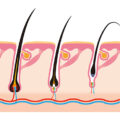Last updated on June 3, 2024
[starbox]
Much like tending to a garden, our scalps require gentle care and nourishment to maintain lush, healthy hair. However, the repeated stress and tension caused by certain hairstyles can disrupt this delicate balance, leading to a specific form of hair loss known as traction alopecia. In this blog post, we’ll explore the causes, symptoms, prevention, and potential treatments of traction alopecia.
Traction alopecia occurs when hair follicles endure prolonged pulling forces due to tight hairstyles. Over time, this ongoing trauma can damage the follicles, resulting in permanent hair loss. The tension applied to the hair leads to inflammation, damage, and scarring of the follicles.
Causes of Traction Alopecia:
Traction alopecia is not an overnight occurrence; it develops gradually. If you consistently wear tight hairstyles over several years, you may notice thinning hair that may not grow back. Weaves, tight ponytails or buns, and even frequently tying wet hair into a bun can contribute to the stress placed on the hair follicles.
Symptoms of Traction Alopecia:
Hair loss is the most prominent symptom of traction alopecia, typically occurring at the hair margins where the pulling forces are strongest. Frontal hairline recession is common, and sometimes, hair loss is preceded by scalp soreness, itching, and bumps. These symptoms should serve as warning signs, prompting you to take preventative measures.
Prevention of Traction Alopecia:
To prevent traction alopecia, it’s crucial to reassess tight hairstyles and give your scalp periodic breaks from them. Avoid damaging hairstyles such as tight braiding, ponytails, flat ironing, and hair extensions. Minimize chemical treatments like coloring and relaxers to reduce the risk of breakage. Maintaining a nutritious diet with adequate protein intake can also support healthy hair growth.
Treatment Options for Traction Alopecia:
Prevention is key when it comes to traction alopecia, as the condition is often irreversible once noticeable hair loss occurs. Giving your scalp a break from tight styles and practicing gentle hair care can help halt further damage. However, if hair loss has already occurred, recovery may be challenging or even impossible. The possibility of recovery depends on the duration of hair loss. In some cases, topical minoxidil prescribed by a Hair Doctor or Hair Specialist may aid in regrowing some hair, but results are not guaranteed.
Final Thoughts:
The good news is that occasional tight hairstyles will not cause permanent hair loss, and you’ll likely experience soreness and irritation before irreversible damage occurs. By avoiding tight styles or providing your scalp with regular breaks, you can prevent traction alopecia and potentially regrow lost hair. It is important to consult with a Hair Doctor or Hair Specialist at the first signs of hair loss to explore potential treatments. Unfortunately, if hair loss has already progressed, scarring of the follicles may have occurred, making regrowth more difficult. In such cases, dermatological interventions like prescription topicals or steroids may be recommended.
Remember, taking proactive measures and seeking professional guidance from a Hair Doctor will help you maintain a healthy scalp and beautiful hair.








